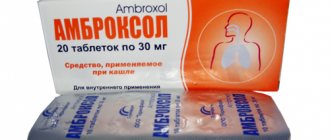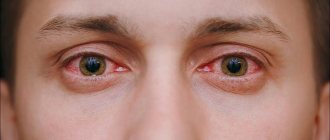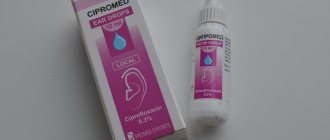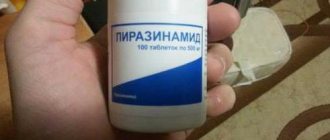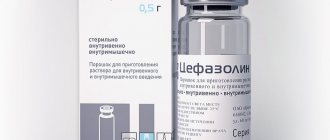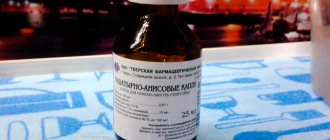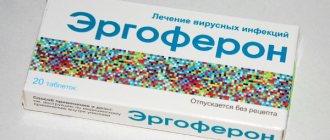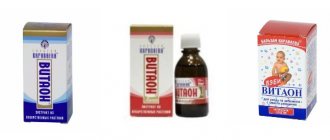Release form and composition
The drug Ibuklin is available in the dosage form of tablets for oral administration, enteric-coated. It contains 2 main active ingredients, the content of 1 tablet is:
- Ibuprofen – 400 mg.
- Paracetamol – 325 mg.
Each tablet also contains:
- Excipients: microcrystalline cellulose 120 mg, corn starch 76 mg, glycerol 3 mg, sodium carboxymethyl starch (type A) 7 mg, colloidal silicon dioxide 5 mg, talc 8 mg, magnesium stearate 6 mg.
- Shell: hypromellose 6 cps 11.32 mg, sunset yellow dye (E110), aluminum varnish 1.78 mg, macrogol-6000 2.2 mg, talc 4.06 mg, titanium dioxide 0.16 mg, polysorbate-80 0, 16 mg, sorbic acid 0.16 mg, dimethicone 0.16 mg.
Pharmacological properties
Pharmacodynamics
A combined drug whose effect is determined by its constituent components.
Ibuprofen
- a non-steroidal anti-inflammatory drug (NSAID), has an analgesic, anti-inflammatory, antipyretic effect. By inhibiting cycloxygenase (COX) 1 and 2, it disrupts the metabolism of arachidonic acid, reduces the amount of prostaglandins (mediators of pain, inflammation and hyperthermic reaction), both in the site of inflammation and in healthy tissues, suppresses the exudative and proliferative phases of inflammation.
Paracetamol
— indiscriminately blocks COX, mainly in the central nervous system, has little effect on water-salt metabolism and the mucous membrane of the gastrointestinal tract (GIT). Has an analgesic and antipyretic effect. In inflamed tissues, peroxidases neutralize the effect of paracetamol on COX 1 and 2, which explains the low anti-inflammatory effect.
The effectiveness of the combination is higher than that of individual components. Relieves arthralgia at rest and during movement, reduces morning stiffness and swelling of joints, and helps increase range of motion.
Pharmacokinetics
After taking the Ibuklin tablet orally, its active ingredients are quickly and almost completely absorbed into the systemic bloodstream from the lumen of the upper digestive tract. They are well distributed in organs and tissues. Ibuprofen accumulates in slightly larger quantities in the structures of the musculoskeletal system. Ibuprofen and paracetamol are metabolized in the liver to form inactive metabolites that are excreted in the urine. The half-life (the time it takes for half the entire dose to be eliminated from the body) is 2-3 hours. The active ingredients of Ibuklin tablets penetrate the blood-brain barrier into the tissues and structures of the central nervous system, as well as into the body of the developing fetus during pregnancy and breast milk during lactation.
What is Ibuklin
The drug contains two active ingredients: ibuprofen and paracetamol. These are effective non-steroidal compounds with analgesic properties. Together they have a more complete therapeutic effect:
- Ibuprofen, with its moderate analgesic properties, more significantly reduces the intensity of inflammation;
- Paracetamol is a good analgesic and relieves painful symptoms for a long time.
Both substances affect thermoregulation centers and normalize body temperature during fever and acute infectious processes.
Ibuklin is produced:
- for adults: in the form of oblong capsules with a film shell: orange. In 1 piece contains 400 mg of ibuprofen and 325 mg of paracetamol;
- for children: Ibuprofen Junior with a measuring spoon in the package: non-coated soluble tablets, pink, with small inclusions, have a mint smell, ibuprofen content - 100 mg, paracetamol - 125 mg.
Additional components of the drug include: talc, silicon, starch, magnesium stearate.
What do Ibuklin tablets help with?
Taking Ibuklin tablets is indicated for pathological conditions that are accompanied by an inflammatory reaction, pain or increased body temperature, these include:
- Fever with increased body temperature, accompanying infectious (including colds) diseases.
- Myalgia is muscle pain.
- Neuralgia is pain in the area of peripheral nerves due to aseptic (non-infectious) inflammation.
- Back pain due to pathology of the spine and spinal roots.
- Post-traumatic or postoperative syndrome with pain of moderate intensity.
- Pain during bruises, sprains, dislocations or subluxations of joints.
- Toothache of moderate intensity.
- Arthralgia is pain in the joints due to inflammation or degenerative processes in them.
- Algodysmenorrhea is painful menstruation in women.
The drug is indicated for the symptomatic treatment of pain, inflammation or fever as part of a complex treatment. It does not affect the course of the pathological process and does not reduce its progression.
Indications
Ibuklin is used independently, as well as in complex treatment, to eliminate negative symptoms:
- for colds, respiratory infections, flu;
- myalgic attacks and neuralgia;
- acute and chronic pathology of the musculoskeletal system;
- dental problems;
- bruises, sprains and other physical injuries;
- postoperative syndrome;
- algomenorrhea;
- migraines.
Contraindications for use
Taking Ibuklin tablets is contraindicated in a number of pathological and physiological conditions of the body, which include:
- Hypersensitivity to the active substances or auxiliary compounds of the drug.
- Peptic ulcer with damage to the gastric or duodenal mucosa in the acute phase of the course - the active ingredients of the drug reduce the level of prostaglandins, which perform a protective function in the structures of the digestive tract.
- Gastrointestinal bleeding in the active phase or in the recent past.
- Renal failure with severe impairment of the functional activity of the kidneys, as well as progressive kidney pathology of any origin.
- Pathological combination of bronchial asthma, polyposis of the nasal mucosa and intolerance to non-steroidal anti-inflammatory compounds.
- Optic nerve damage.
- Pathology of the blood system.
- The recovery period after surgery for coronary artery bypass grafting.
- Genetic absence of the enzyme glucose-6-phosphate dehydrogenase.
- Active inflammatory or degenerative liver disease, as well as liver failure.
- Inflammatory pathology of the small or large intestine.
- Age up to 12 years.
- Pregnancy in the third trimester of its course.
The drug is used with caution in chronic cardiovascular pathology (coronary heart disease, cerebral atherosclerosis, heart failure), diabetes mellitus, pathology of peripheral arteries, smoking. Before starting to take Ibuklin tablets, it is important to make sure that there are no contraindications.
Directions for use and dosage for adults
Orally (before or 2-3 hours after meals), without chewing, with a sufficient amount of water. Adults and children over 12 years old - 1 tablet 2-3 times a day. The minimum interval between taking the drug is 4 hours. Maximum dosage for adults: single - 2 tablets, daily - 6 tablets.
In case of impaired renal or liver function, for elderly patients, the interval between doses of the drug should be at least 8 hours.
The drug should not be taken for more than 5 days as an analgesic and for more than 3 days as an antipyretic without medical supervision.
Boric acid
People began to use the analgesic and antiseptic properties of this drug back in the 19th century. Today, an alcohol solution of acid - boric alcohol - is more often used. This remedy is also very popular, especially in the treatment of otitis; in terms of its effectiveness, it is even compared with the antibiotic ciprofloxacin. But the properties of acid to accumulate and be slowly eliminated from the body require great caution when used, especially for treating children. How to use boric acid to relieve pain in an inflamed ear?
- You can drip boric alcohol (3-4 drops), after carefully cleaning the ear with a cotton swab dipped in a solution of hydrogen peroxide.
- The best way is to leave a turunda moistened with boric alcohol in the sore ear overnight.
Using boric alcohol in cases of damage to the eardrum, injuries or abrasions of the ear canal is strictly prohibited, as this can lead to hearing impairment.
Side effects
Taking pills can lead to the development of side effects from various organs and systems:
- Digestive system - a pathological symptom complex in the form of gastropathy induced by non-steroidal anti-inflammatory compounds (nausea, vomiting, abdominal pain, loss of appetite, bloating, diarrhea). Less commonly, erosive lesions of the mucous membrane of the digestive tract, toxic inflammation of the liver (hepatitis) with its functional failure, inflammation of the pancreas (pancreatitis), dryness of the oral mucosa, its irritation, aphthous stomatitis with the formation of erosions of the oral mucosa can develop.
- Nervous system - dizziness, headache, sleep disturbance, irritability, nervousness, agitation, depression (prolonged and severe decrease in mood), confusion, visual or auditory hallucinations, aseptic meningitis (non-infectious inflammation of the meninges) rarely develops.
- Sense organs – decreased hearing acuity, toxic damage to the optic nerve, blurred vision, double vision, tinnitus, scotoma (spot before the eyes), amblyopia (weakened visual acuity that cannot be corrected with glasses or contact lenses).
- Blood and red bone marrow - anemia (anemia), thrombocytopenia (decreased number of platelets in the blood), agranulocytosis (virtual absence of granulocyte immune cells).
- Cardiovascular system - increased blood pressure, tachycardia (increased heart rate), development of heart failure.
- Respiratory system - shortness of breath and bronchospasm (narrowing of the bronchi due to increased contraction of the smooth muscles of their walls).
- Urinary system - nephritis (inflammation of kidney tissue), acute failure of functional activity of the kidneys, nephrotic syndrome, polyuria (increased daily urine volume).
- Allergic reactions - rash and itching of the skin, urticaria (a characteristic rash reminiscent of a nettle burn), angioneurotic angioedema (significant swelling of soft tissues, mainly the face and genitals), bronchospasm (allergic narrowing of the bronchi with shortness of breath), allergic conjunctivitis (specific inflammation conjunctiva of the eyes), anaphylactic shock (systemic reaction with decreased blood pressure and multiple organ failure), exudative erythema, toxic epidermal necrolysis (Lyell's syndrome).
Also, under the influence of the drug, glucose levels in the blood may decrease. The risk of developing bleeding from the gastrointestinal tract and the formation of erosions and ulcers of its mucous membrane increases with long-term use of Ibuklin tablets. The development of side effects is grounds for discontinuation of the drug.
Contraindications and adverse reactions
According to the instructions, the drug should not be taken in the following cases:
- liver problems;
- impaired blood supply;
- excessive sensitivity to the constituent components of the drug;
- acute diseases of the stomach and intestines;
- bearing a child;
- lactation period.
It should be taken with great caution when:
- poor blood clotting;
- kidney problems;
- gastrointestinal bleeding;
- heart failure;
- intestinal disorders;
- bronchial asthma.
After taking Ibuklin, undesirable reactions may occur from many systems of the human body: cardiac, nervous, gastrointestinal, vascular, respiratory, genitourinary. Side effects include:
- vomiting, nausea;
- constant anxiety;
- increased blood pressure;
- dizziness, rapid heartbeat;
- pain in the stomach and head;
- stress, depression;
- deterioration of hearing and visual acuity.
With prolonged use of tablets in an excessive dose, vision may sharply decrease and stomach bleeding may occur. If adverse reactions occur, you should consult a doctor to find an analogue.
Cases of overdose are possible. They are manifested by the side reactions described above.
special instructions
Before you start taking Ibuklin tablets, you must carefully read the instructions for the drug. There are a number of special instructions that are important to pay attention to:
- The simultaneous use of the drug with other non-steroidal anti-inflammatory drugs is excluded.
- If it is necessary to take concurrent medications with indirect anticoagulants, it is recommended to carry out periodic laboratory monitoring of blood coagulation parameters (hemostasis indicators).
- If it is necessary to take Ibuklin tablets for a longer period of time (more than 5-7 days), it is important to carry out laboratory monitoring of indicators of the functional state of the blood.
- It is not recommended to drink alcohol during treatment with the drug to prevent toxic effects on the liver.
- Taking the drug may distort some laboratory test parameters, in particular the level of glucose and uric acid in the blood.
- Taking the drug does not have a direct effect on the speed of psychomotor reactions and the ability of the cerebral cortex to concentrate. However, during the period of its use, it is recommended to avoid activities that require increased attention.
Features of therapy
In order for drug therapy to take place without unpleasant consequences, all necessary dosage requirements, according to the instructions, must be observed.
Use during pregnancy
It is possible to reduce the temperature with Ibuklin even in the first trimesters of pregnancy, since experimental studies have not revealed a serious effect of the drug on the fetus. However, such therapy is only possible with medical prescription, when all possible risks to the fetus have been assessed. In the later stages, taking Ibuklin is strictly prohibited.
Concomitant use with medications containing paracetamol or ibuprofen
Simultaneous use of Ibuklin with medications that include ibuprofen or paracetamol can lead to an overdose and side effects. If for any reason the drug is taken for longer than the time specified in the instructions, there should be constant monitoring of blood counts and liver condition.
Taking with other medications
Concomitant use with other medications may affect the effectiveness of Ibuklin and those medications that are taken with it. If you have any doubts about the safety of taking drugs together, you should consult your doctor.
Important! For adults with fever, Ibuklin should not be combined with alcohol-containing drinks, as this endangers the liver and can lead to damage to the gastrointestinal tract.
| No. | Medicines | Possible negative effect |
| 1 | Lithium preparations | Blood concentration increases |
| 2 | Methotrexate | |
| 3 | Digoxin | |
| 4 | Diuretics | Reduced efficiency |
| 5 | Insulin | Strengthening the action |
| 6 | Hypoglycemic oral drugs | |
| 7 | Anticoagulants | Hemorrhagic complications may occur |
| 8 | Glucocorticosteroids | Gastrointestinal ulcers |
| 9 | Aspirin | Reduced efficiency |
| 10 | Caffeine | Enhances the effect of ibuprofen |
| 10 | Antacids | Reduced effectiveness of Ibuprol |
| 11 | Cyclosporins | Increased kidney toxicity |
Cases of overdose
Exceeding the recommended dose of the drug most often has manifestations from the gastrointestinal tract, in addition, the patient may experience the following symptoms:
- drowsiness;
- slowness of reactions;
- headache;
- convulsions;
- blood pressure disorders, etc.
In case of overdose, the patient must undergo symptomatic treatment. Do gastric lavage as early as possible. If more than 4 hours have passed, this technique will not be effective.
In addition, the patient is prescribed alkaline mineral water and sorbents. Therapy depends on the size of the overdose and the amount of time that has passed since taking it.
Analogs
If it is impossible to take Ibuklin, the doctor may recommend one of the analogues to the patient. For example, Next or Brustan, which contain the same active substances as Ibuklin.
For your information! It is not advisable to replace one drug with another on your own, since even drugs with similar effects may have different administration characteristics, age restrictions and contraindications.
An alternative to Ibuklin are products that contain ketorolac and indomethacin. In addition to a good antipyretic effect, these substances have an anti-inflammatory effect and provide good anesthesia. Their concentration in the blood is achieved quickly, which provides relief in less than half an hour.
Ibuklin is an effective drug designed to reduce fever and relieve pain. This product is approved for use in pediatrics and can be used to treat children and adults at home.
Overdose
Symptoms
Gastrointestinal disorders (diarrhea, nausea, vomiting, anorexia, epigastric pain), increased prothrombin time, bleeding after 12-48 hours, lethargy, drowsiness, depression, headache, tinnitus, impaired consciousness, heart rhythm disturbances , decreased blood pressure, manifestations of hepato- and nephrotoxicity, convulsions, possible development of hepatonecrosis.
Treatment
Gastric lavage during the first 4 hours; alkaline drinking, forced diuresis; activated carbon orally, administration of SH-group donors and precursors for the synthesis of glutathione - methionine 8-9 hours after an overdose and N-acetylcysteine orally or intravenously - after 12 hours, antacid drugs; hemodialysis; symptomatic therapy. The need for additional therapeutic measures (further administration of methionine, intravenous administration of N-acetylcysteine) is determined depending on the concentration of paracetamol in the blood, as well as the time elapsed after its administration.
IBUCLIN®
INSTRUCTIONS for use of the medicinal product for medical use IBUCLIN®
Registration number: P N011252/01
Trade name of the drug: Ibuklin®
INN or generic name of the drug: Ibuprofen + Paracetamol
Dosage form: film-coated tablets
Composition Each film-coated tablet contains: Active ingredients: ibuprofen 400 mg and paracetamol 325 mg. Excipients: microcrystalline cellulose 120 mg, corn starch 76 mg, glycerol 3 mg, sodium carboxymethyl starch (type A) 7 mg, colloidal silicon dioxide 5 mg, talc 8 mg, magnesium stearate 6 mg. Shell: hypromellose 6 pps 11.32 mg, sunset yellow dye (E110), aluminum varnish 1.78 mg, macrogol-6000 2.2 mg, talc 4.06 mg, titanium dioxide 0.16 mg, polysorbate-80 0, 16 mg, sorbic acid 0.16 mg, dimethicone 0.16 mg.
Description Capsule-shaped, orange-coated tablets with a score line on one side; For individual tablets, marbling of color is allowed.
Pharmacotherapeutic group: combined analgesic drug (NSAID + analgesic non-narcotic drug).
ATX code: M01AE51
Pharmacological properties
Pharmacodynamics A combined drug whose effect is determined by its constituent components. Ibuprofen is a nonsteroidal anti-inflammatory drug (NSAID) that has analgesic, anti-inflammatory, and antipyretic effects. By inhibiting cycloxygenase (COX) 1 and 2, it disrupts the metabolism of arachidonic acid, reduces the amount of prostaglandins (mediators of pain, inflammation and hyperthermic reaction), both in the site of inflammation and in healthy tissues, suppresses the exudative and proliferative phases of inflammation. Paracetamol - indiscriminately blocks COX, mainly in the central nervous system, has little effect on water-salt metabolism and the mucous membrane of the gastrointestinal tract (GIT). Has an analgesic and antipyretic effect. In inflamed tissues, peroxidases neutralize the effect of paracetamol on COX 1 and 2, which explains the low anti-inflammatory effect. The effectiveness of the combination is higher than that of individual components. Relieves arthralgia at rest and during movement, reduces morning stiffness and swelling of joints, and helps increase range of motion.
Pharmacokinetics
Ibuprofen. Absorption is high, quickly and almost completely absorbed from the gastrointestinal tract (GIT). The time to reach maximum concentration (TCmax) after oral administration is about 1-2 hours. Communication with blood plasma proteins is more than 90%. The half-life (T1/2) is about 2 hours. It slowly penetrates into the joint cavity, accumulates in the synovial fluid, creating higher concentrations in it than in the blood plasma. After absorption, about 60% of the pharmacologically inactive R-form is slowly transformed into the active S-form. Metabolized. More than 90% is excreted by the kidneys (no more than 1% unchanged) and, to a lesser extent, with bile in the form of metabolites and their conjugates.
Paracetamol. Absorption is high, binding to plasma proteins is less than 10% and increases slightly with overdose. Sulfate and glucuronide metabolites do not bind to plasma proteins even at relatively high concentrations. The Cmax value is 5-20 μg/ml, TCmax is 0.5-2 hours. Distributed fairly evenly in body fluids. Penetrates the blood-brain barrier. About 90-95% of paracetamol is metabolized in the liver to form inactive conjugates with glucuronic acid (60%), taurine (35%) and cysteine (3%), as well as a small amount of hydroxylated and deacetylated metabolites. A small portion of the drug is hydroxylated by microsomal enzymes to form highly active N-acetyl-n-benzoquinone imine, which binds to the sulfhydryl groups of glutathione. When glutathione reserves in the liver are depleted (in case of overdose), the enzyme systems of hepatocytes can be blocked, leading to the development of their necrosis. T1/2 – 2-3 hours. In patients with liver cirrhosis, T1/2 increases slightly. In elderly patients, drug clearance decreases and T1/2 increases. It is excreted by the kidneys mainly in the form of glucuronide and sulfate conjugates (less than 5% unchanged). Less than 1% of the administered dose of paracetamol passes into breast milk. In children, the ability to form conjugates with glucuronic acid is lower than in adults.
- - symptomatic treatment of infectious and inflammatory diseases (colds, flu), accompanied by fever, chills, headache, muscle and joint pain, sore throat;
- - myalgia;
- - neuralgia;
- - back pain;
- — joint pain, pain syndrome in inflammatory and degenerative diseases of the musculoskeletal system;
- - pain from bruises, sprains, dislocations, fractures;
- — post-traumatic and postoperative pain syndrome;
- - toothache;
- - algodismenorrhea (painful menstruation).
Indications for use
The drug is intended for symptomatic therapy, reducing pain and inflammation at the time of use, and does not affect the progression of the disease.
Contraindications for use: Increased individual sensitivity to the components of the drug (including other NSAIDs), peptic ulcer of the stomach and duodenum in the acute phase, gastrointestinal bleeding, severe renal failure (creatinine clearance (CC) less than 30 ml/min), complete or an incomplete combination of bronchial asthma, recurrent polyposis of the nose and paranasal sinuses and intolerance to acetylsalicylic acid or other NSAIDs (including a history), damage to the optic nerve, genetic absence of glucose-6-phosphate dehydrogenase, diseases of the blood system, the period after coronary artery bypass surgery; progressive kidney disease, severe liver failure or active liver disease, confirmed hyperkalemia, active gastrointestinal bleeding, inflammatory bowel disease, pregnancy (III trimester), children under 12 years of age.
Use during pregnancy and lactation In the first and second trimesters of pregnancy, use is possible only as prescribed by a doctor in cases where the potential benefit outweighs the possible risk to the mother and the potential risk to the fetus. The use of the drug in the third trimester of pregnancy is contraindicated. If it is necessary to use the drug during lactation (breastfeeding), breastfeeding should be stopped. Experimental studies have not established the embryotoxic, teratogenic and mutagenic effects of the components of the drug Ibuklin ®.
Method of administration and dosage regimen: Orally (before or 2-3 hours after meals), without chewing, with a sufficient amount of water. For adults. 1 tablet 3 times a day. The maximum daily dose is 3 tablets. Children over 12 years old (body weight more than 40 kg). 1 tablet 2 times a day. The duration of treatment is no more than 3 days as an antipyretic and no more than 5 days as an analgesic. Continuation of treatment with the drug is possible only after consultation with a doctor.
Precautions for use: Coronary heart disease, chronic heart failure, cerebrovascular diseases, dyslipidemia/hyperlipidemia, diabetes mellitus, peripheral arterial disease, smoking, creatinine clearance less than 60 ml/min, history of ulcerative lesions of the gastrointestinal tract, presence of Helicobacter pylori infection, elderly age, long-term use of NSAIDs, alcoholism, severe somatic diseases, simultaneous use of oral glucocorticosteroids (including prednisolone), anticoagulants (including warfarin), antiplatelet agents (including acetylsalicylic acid, clopidogrel), selective serotonin reuptake inhibitors (including citalopram, fluoxetine, paroxetine, sertraline). Viral hepatitis, liver and/or kidney failure of moderate and mild severity, benign hyperbilirubinemia (Gilbert, Dubin-Johnson and Rotor syndrome), liver cirrhosis with portal hypertension, nephrotic syndrome.
Symptoms of overdose, measures to assist in case of overdose Symptoms: gastrointestinal disorders (diarrhea, nausea, vomiting, anorexia, epigastric pain), increased prothrombin time, bleeding after 12-48 hours, lethargy, drowsiness, depression, headache, tinnitus, impaired consciousness, heart rhythm disturbances, decreased blood pressure, manifestations of hepato- and nephrotoxicity, convulsions, possible development of hepatonecrosis. If you suspect an overdose, you should immediately seek medical help. Treatment: gastric lavage during the first 4 hours; alkaline drinking, forced diuresis; activated carbon orally, administration of SH-group donors and precursors for the synthesis of glutathione-methionine 8-9 hours after an overdose and N-acetylcysteine orally or intravenously after 12 hours, antacid drugs; hemodialysis; symptomatic therapy. The need for additional therapeutic measures (further administration of methionine, intravenous administration of N-acetylcysteine) is determined depending on the concentration of paracetamol in the blood, as well as the time elapsed after its administration.
Possible side effects From the gastrointestinal tract (GIT): NSAID gastropathy - nausea, vomiting, heartburn, anorexia, discomfort or pain in the epigastrium, diarrhea, flatulence; rarely – erosive and ulcerative lesions, bleeding; liver dysfunction, hepatitis, pancreatitis; irritation or dryness in the mouth, pain in the mouth, ulceration of the gum mucosa, aphthous stomatitis; constipation. From the nervous system and sensory organs: headache, dizziness, insomnia, anxiety, nervousness, irritability, agitation, drowsiness, depression, confusion, hallucinations; rarely – aseptic meningitis (more often in patients with autoimmune diseases); hearing loss, tinnitus, blurred vision, toxic damage to the optic nerve, blurred vision or double vision, scotoma, amblyopia. From the cardiovascular system: heart failure, increased blood pressure, tachycardia. From the hematopoietic organs: anemia (including hemolytic and aplastic), thrombocytopenia, thrombocytopenic purpura, agranulocytosis, leukopenia. From the respiratory system: shortness of breath, bronchospasm. From the urinary system: allergic nephritis, acute renal failure, nephrotic syndrome, edema, polyuria, cystitis. Allergic reactions: skin rash, itching, urticaria, Quincke's edema, bronchospasm, dyspnea, allergic rhinitis, dry and irritated eyes, swelling of the conjunctiva and eyelids, eosinophilia, fever, anaphylactic shock, erythema multiforme exudative (Stevens-Johnson syndrome), toxic epidermal necrolysis (Lyell's syndrome). Laboratory indicators: decrease in serum glucose concentration, decrease in hematocrit and hemoglobin, increase in bleeding time, increase in serum creatinine concentration, increase in the activity of “liver” transaminases. Other: increased sweating. With long-term use in high doses: ulceration of the mucous membrane of the gastrointestinal tract, bleeding (gastrointestinal, gingival, uterine, hemorrhoidal), visual impairment (impaired color vision, scotoma, amblyopia).
Interaction with other drugs and (or) food products When using the drug Ibuklin ® simultaneously with drugs, various interaction effects may develop. When taken simultaneously with acetylsalicylic acid, ibuprofen reduces its anti-inflammatory and antiaggregation effect (an increase in the incidence of acute coronary insufficiency in patients receiving small doses of acetylsalicylic acid as an antiaggregation agent is possible after the start of administration). Combination with ethanol, glucocorticosteroids, corticotropin increases the risk of erosive and ulcerative lesions of the gastrointestinal tract. Ibuprofen enhances the effect of direct (heparin) and indirect (coumarin and indanedione derivatives) anticoagulants, thrombolytic agents (alteplase, anistreplase, streptokinase, urokinase), antiplatelet agents, colchicine - the risk of developing hemorrhagic complications increases. Enhances the hypoglycemic effect of insulin and oral hypoglycemic drugs. Weakens the effects of antihypertensive drugs and diuretics (by inhibiting the synthesis of renal prostaglandins). Increases the blood concentration of digoxin, lithium and methotrexate. Caffeine enhances the analgesic effect of ibuprofen. Cyclosporine and gold preparations increase nephrotoxicity. Cefamandole, cefoperazone, cefotetan, valproic acid, plicamycin increase the incidence of hypoprothrombinemia. Antacids and cholestyramine reduce the absorption of the drug. Myelotoxic drugs contribute to the manifestation of hematotoxicity of the drug.
Special instructions Avoid simultaneous use of the drug with other drugs containing paracetamol and/or non-steroidal anti-inflammatory drugs. When using the drug for more than 5-7 days as prescribed by a doctor, peripheral blood counts and the functional state of the liver should be monitored. With the simultaneous use of indirect anticoagulants, it is necessary to monitor the indicators of the blood coagulation system. Co-administration of Ibuklin ® with other NSAIDs should be avoided. To avoid possible damaging effects on the liver, you should not drink alcohol while taking the drug. The drug may distort the results of laboratory tests when quantitatively determining glucose, uric acid in blood serum, and 17-ketosteroids (the drug must be discontinued 48 hours before the test).
Impact on the ability to drive vehicles and machinery During the treatment period, the patient should refrain from engaging in potentially hazardous activities that require increased attention and speed of psychomotor reactions.
Release form: Film-coated tablets, 400 mg + 325 mg. 10 tablets in a PVC/Al blister. 1, 2 or 20 blisters are packed in a cardboard pack with instructions for use.
Storage conditions: In a dry place, protected from light and out of reach of children, at a temperature not exceeding 25 °C.
Shelf life: 5 years. Do not use after the expiration date stated on the packaging.
Conditions for dispensing from pharmacies Without a prescription.
Manufacturer Dr. Reddy's Laboratories Ltd. Hyderabad, Andhra Pradesh, India.
Manufacturing address Dr. Reddy's Laboratories Ltd. Plot No. 137, 138 and 146, Sri Venkateswara Cooperative Industrial Complex, Bollaram, Jinnaram Mandal, Medak District, Andhra Pradesh, India.
Send consumer complaints to the following address: Representative office of Dr. Reddy's Laboratories Ltd.: 115035, Moscow, Ovchinnikovskaya embankment, 20, building 1 Tel, 783-29-01 Fax
Use during pregnancy and lactation
If it is necessary to use Ibuklin tablets during pregnancy and lactation (breastfeeding), you should carefully weigh the expected benefits of therapy for the mother and the potential risk for the fetus or child.
If it is necessary to use it in the first trimester of pregnancy, long-term use of the drug Ibuklin should be avoided.
If short-term use of the drug Ibuklin is necessary during lactation, cessation of breastfeeding is usually not required. Experimental studies have not established the embryotoxic, teratogenic and mutagenic effects of the components of the drug Ibuklin.
Ibuklin for flu and colds
The described drug is in great demand by patients in the therapeutic department, especially during epidemics of acute respiratory infections. When drawing up a comprehensive course of therapy, specialists regularly prescribe Ibuklin - which is what this drug helps with:
- high body temperature;
- feverish conditions;
- signs of the inflammatory process;
- headache;
- aches in muscles and joints.
Ibuklin for colds and various types of influenza virus effectively, quickly and safely relieves all unpleasant symptoms of the pathology. Thanks to this analgesic-antipyretic, patients can get a good night's sleep and continue adequate treatment of the cause of the infectious disease. The pharmacological agent accelerates recovery and prevents complications.
